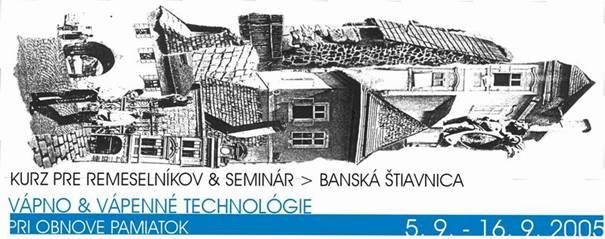Lime & Lime Technologies in the Preservation of the Built Heritage Conservation

The Workshop „Lime & Lime Technologies in the Preservation of the Built Heritage Conservation“ which was held in Banska Stiavnica, Slovakia, in 05.-16.09.2005, will certainly be one of those events that every of its participants will remember for years.It will be not only due to the wonderful atmosphere created by the participants and organizers but also due to its priceless value of scientific meeting supported by practical experience.
The main goal of the workshop was to show the way the lime was used in traditional building technologies and how it should be used nowadays in the preservation of built heritage. It tried to find out how we should treat lime-based historical elements of the building and how to avoid in the renovation process the mistakes which are caused by the use of modern industrial materials.
The basic advantage of the workshop was the opportunity of training on the building site in renovated Renaissance building which masonry work is done with the use of lime-mortar, and its facades are covered by the colourful map of lime plasters and paints coming from many periods and now in various technical condition.
Listening to the one hour lecture in the morning had been very good introduction to the work we did later during every day of the course. Alternating of theoretical and practical hours gave an unique opportunity of an almost immediate test of the acquired knowledge on building site. The work in the renovated building gave us the opportunity to trace the whole renovation process. It begun with the lime-mortar structural research, lime plasters layers and paint coats historical stratification, valuation of technical condition of plasters and paints and salt content research of mortars and plasters. The research was followed by the preservation and reinforcement of the plaster layers damaged by salt decay, subflorscence and efflorescence. In the meantime the damaged parts of masonry were filled up with the use of stone material from the site and with the use of lime mortar prepared on the site. It was the best way to know the properties of the quicklime based mortar – just to work with it. Equally superb was the experience with consolidation of deteriorated parts of historical plasters. Certainly, patience is not the thing you could learn in one day but we already know the basic rules and everyone can practice it by himself. Perhaps the best was the work with the plasters based on the quicklime. The good thing was that we learn not only to apply typical three-coat work of scratch coat, brown coat and finish coat but we also learn something about some decorative techniques. Very interesting, but too short for some people I think, was the part of the course referring to the topic of lime based paints. The necessity of renovation works forced us also to know the whole process of preparing of the essential building materials on site. Every participant could learn then how to prepare lime mortar with the quicklime so as proper lime plaster, „lime milk“ for renovation works and, in the end, whitewash and lime based paints. Only just after the course, getting back to everyday work, many of us realised how the renovation process is dominated by the unified modern materials which in many cases are not used properly. Working with quicklime appears as some ancient, almost sacred knowledge of which everybody knows everything but nobody wants to use, relaying on ready-made materials. I think that for some participants, mainly craftsmen, the workshop could be a nice chance to break this sort of aversion to this great traditional material.
Interesting thing was that the organizers managed to gather on one building site some craftsmen, architects, art historians, renovators and students learning issues related closely to the subject of the course. It gave really positive mixture of some fresh attitude and the experience within the cooperation of people which were interested in the subject of the course and in raising of their skills. Although the organizers were disappointed that local craftsmen had not been interested in taking part in the course, people gathered on the site managed to form good team in short time. And in fact craftsmen working out of their natural “business environment” were probably more willing to learn and change experiences and ideas.
Certainly the meeting of people from a few countries on one building place also enlarged some linguistic knowledge of professional vocabulary, not always „educationally correct“ but still very useful. Communication problems were not probably the cause of some little weakness of the workshop. It was due to the strictly technological profile of the course that we have really not too much discussions focused on some theoretical topics including some esthetical, historical and conservation-theory problems. The seminar compensated it somehow but certainly it would be better to discuss things on the site. Craftsmen are in many cases really interested in taking part in such discussions but they usually cannot do it in regular circumstances. On the other hand we certainly cannot do everything in two weeks time.
In the end something about building of the lime kiln and burning lime stone must be said. Although the whole operation was not completely successful it taught us a lot about the value of the material we worked with and about problems of its quality. It also showed us precisely that the work within the team is not only great fun but it demands real discipline if we want to have the effect.
Due to the renovation of some specific object the course was not ordinary learning meeting but gave some measurable effect. It also created the feeling of responsibility for the works that had been done. So participants did not have to deal with regular school exercises but with the real work which probably would have some useful effect. Even if only the small progress of renovation of the building of Remeselnicka 5 was done it should be considered as the success because in this area of activity success is not something usual.
Tomasz Wolender
Wojewódzki Urząd Ochrony Zabytków w Szczecinie
ul. Kuśnierska 14a
70-536 Szczecin
Poland
tel./fax +4891 4337066
tomasz.wolender@wkz.szczecin.pl
– Vápno a vápenné technológie pri obnove pamiatok
– Discusion group


